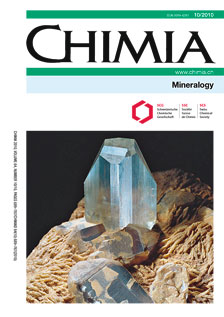A Novel Route for the Synthesis of Mesoporous and Low-Thermal Stability Materials by Coupled Dissolution-Reprecipitation Reactions: Mimicking Hydrothermal Mineral Formation
DOI:
https://doi.org/10.2533/chimia.2010.693Keywords:
Copper-indium sulphide, Coupled dissolution reprecipitation reaction, Materials synthesis, Mineral replacement, Nanozeolites, Porous gold, ThiospinelsAbstract
Replacement reactions ('pseudomorphism') commonly occur in Nature under a large range of conditions (T 25 to >600 °C; P 1 to >5 kbar). Whilst mineral replacement reactions are often assumed to proceed by solid-state diffusion of the metal ions through the mineral, many actually proceed via a coupled dissolution and reprecipitation (CDR) mechanism. In such cases, a starting mineral is dissolved into a fluid and this dissolution is coupled with the precipitation of a replacement phase across the reaction front. In cases where there are close relationships between the crystal structures of the parent and newly formed minerals, the replacement can be topotactic (interface-coupled dissolution and reprecipitation). The kinetics and chemistry of the CDR route are fundamentally different from solid-state diffusion and can be exploited i) for the synthesis of materials that are often difficult to synthesise via traditional methods and ii) to obtain materials with unique properties. This review highlights recent research into the use of CDR for such synthetic challenges. Emphasis has been given to i) the use of CDR to synthesise compounds with relatively low thermal stability such as the thiospinel mineral violarite ((Ni,Fe)3S4), ii) preliminary work into use of CDR for the production of roquesite (CuInS2), a potentially important photovoltaic component and, iii) examples where the textures resulting from CDR reactions are controlled by the nature and texture of the parent phase and the reaction conditions; these being the formation of micro-porous gold and three-dimensional ordered arrays of nanozeolite of uniform size and crystallographic orientation.Downloads
Published
2010-10-29
Issue
Section
Scientific Articles
License
Copyright (c) 2010 Swiss Chemical Society

This work is licensed under a Creative Commons Attribution-NonCommercial 4.0 International License.
How to Cite
[1]
Chimia 2010, 64, 693, DOI: 10.2533/chimia.2010.693.







